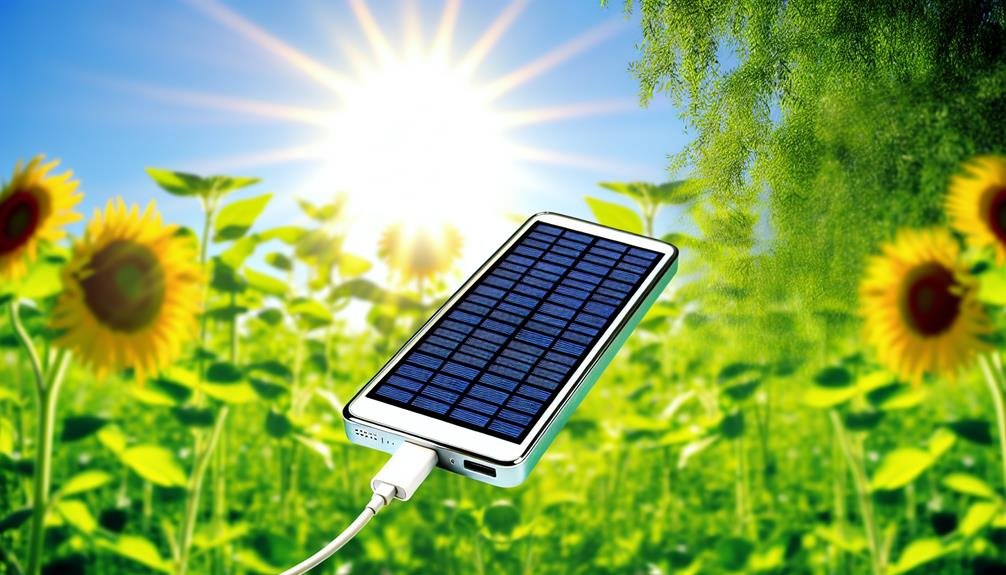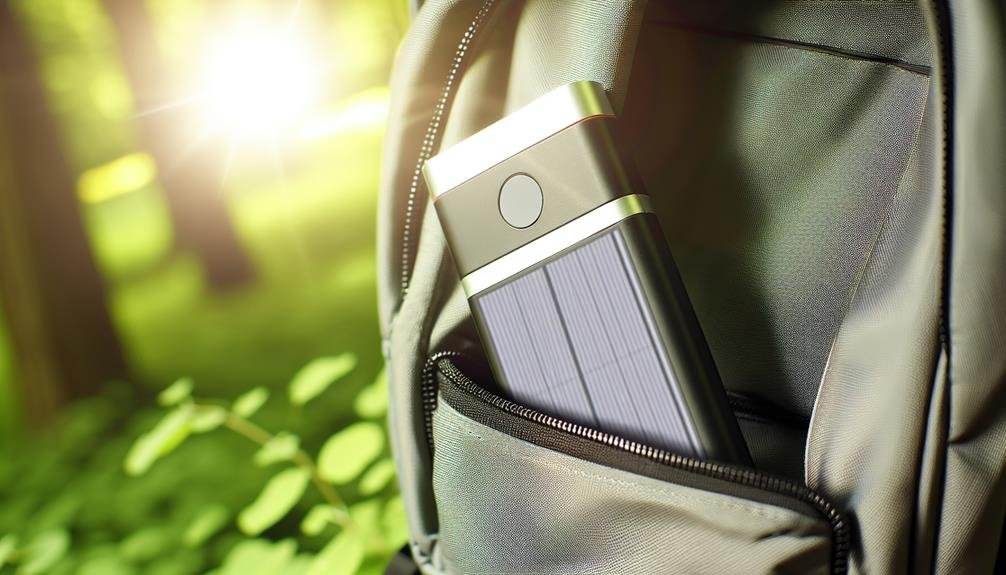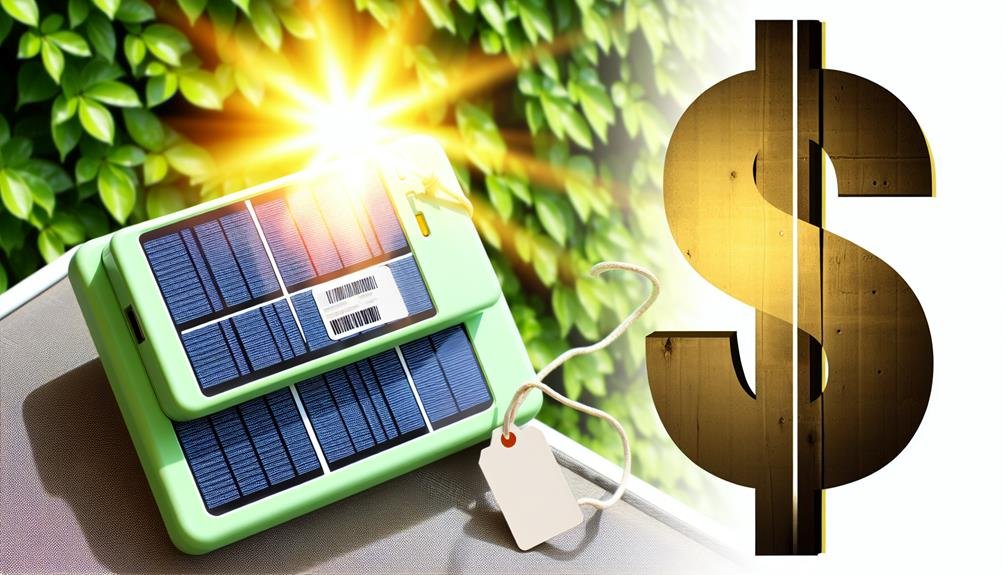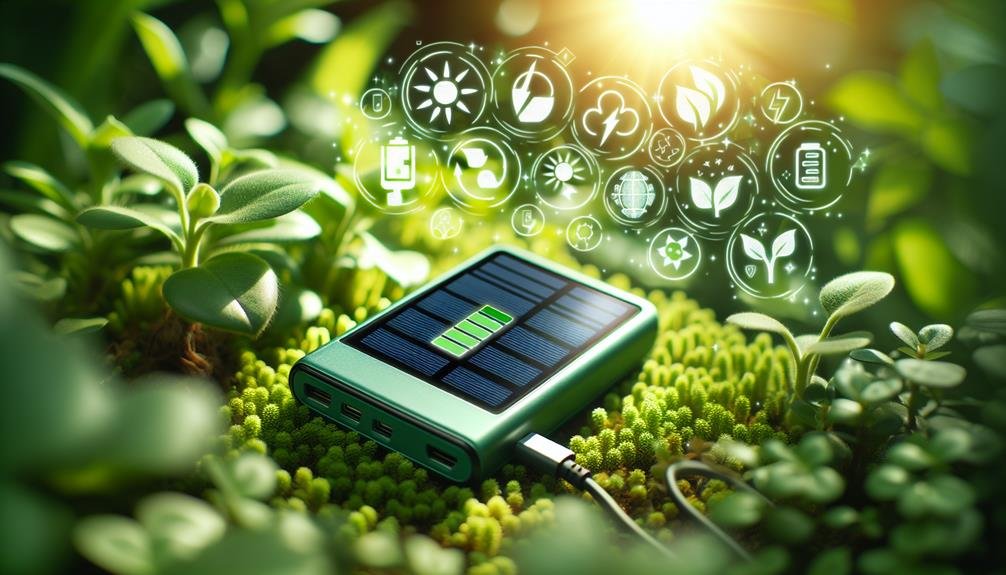Yes, solar powered power banks are quite effective and eco-friendly. They employ advanced photovoltaic cells with 15-20% efficiency to convert sunlight into DC electricity. Their performance depends on sunlight exposure, making them ideal for outdoor use. Quality can vary with battery capacity, charging speed, and weather conditions playing pivotal roles. While the initial cost is higher than traditional models, long-term savings through reduced grid reliance and significant environmental benefits—like up to 30% lower household carbon footprint—add value. Discover more about their efficiency, design, and user experiences to see if they meet your needs.
How Solar Power Banks Work

Solar power banks function by converting sunlight into electrical energy through photovoltaic cells, which are integrated into the device's structure. These cells absorb sunlight and transform it into direct current (DC) electricity. The efficiency of the solar panels is a crucial factor; higher efficiency means more electricity is generated from the same amount of sunlight. Typically, modern solar panels have efficiencies ranging from 15% to 20%.
Battery capacity is another essential aspect. You'll find that power banks with larger battery capacities can store more energy, providing more charges for your devices. For example, a 10,000 mAh battery can charge a typical smartphone approximately three times before needing a recharge itself.
Charging speed is influenced by the intensity of sunlight exposure. Ideal sunlight conditions, such as direct midday sun, can greatly enhance the charging speed. However, in low-light conditions or on cloudy days, anticipate a slower charging process.
Safety features, including overcharge protection and temperature regulation, are integrated to guarantee your devices and the power bank itself remain safe during operation. Be mindful of these technical details to maximize efficiency and maintain safety while using solar power banks.
Charging Efficiency
When evaluating charging efficiency, you'll find that the conversion rate from sunlight to usable electrical energy is a critical determinant, often quantified by the panel's efficiency percentage and influenced by external factors like sunlight intensity and angle of incidence. High-efficiency panels, typically those with efficiency rates above 20%, will capture and convert more sunlight into electrical energy, directly impacting the charging speed of your devices.
However, charging efficiency isn't just about the panel's performance. The intensity of sunlight plays a significant role. On a cloudy day or when the sun is at a lower angle, the energy conversion drops, leading to slower charging speeds. This can be particularly crucial if you rely on your power bank for emergency situations.
Battery life is another factor intertwined with charging efficiency. The quality of the battery within the power bank determines how well it can store the converted energy and how effectively it can transfer that stored energy to your devices. A high-capacity battery with a long life will guarantee consistent performance, but only if the solar panels can effectively charge it.
Portability and Design

In evaluating the portability and design of solar-powered power banks, you'll find that compactness and weight are essential metrics, directly impacting the usability and convenience for users on the go. Modern solar power banks are available in various size options, ranging from pocket-sized units to larger models designed for extended outdoor use. The weight is generally kept to a minimum, often utilizing lightweight yet durable materials such as polycarbonate and aluminum alloys to guarantee easy transport without sacrificing structural integrity.
When it comes to aesthetics, manufacturers offer a range of color choices to appeal to different consumer preferences. Beyond appearance, the design incorporates practical elements like ergonomic grips and integrated carabiners, enhancing portability for outdoor activities. Durability is a critical factor; many models boast shockproof and dustproof features to withstand harsh environments. Waterproofing is also a common attribute, adhering to IP67 or higher standards, securing the devices can endure exposure to rain or accidental submersion.
Environmental Impact
By opting for solar powered power banks, you greatly reduce your carbon footprint, as they utilize renewable energy sources instead of fossil fuels. Data indicates that solar energy generation emits 20 times less CO2 compared to traditional electricity production. Additionally, reliance on solar power mitigates the depletion of non-renewable natural resources, promoting sustainable energy consumption.
Reduced Carbon Footprint
Harnessing solar energy for power banks greatly reduces carbon emissions by utilizing renewable energy sources instead of relying on fossil fuels. This eco-friendly technology offers significant energy savings by converting sunlight into electrical energy, thereby diminishing the need for conventional electricity. When you opt for solar-powered power banks, you're contributing to a decrease in greenhouse gas emissions, a critical factor in combating climate change.
Studies indicate that the average household can reduce its carbon footprint by up to 30% through the adoption of solar technologies. Solar power banks employ photovoltaic cells to capture and store solar energy, which is then used to charge your devices. By using these eco-friendly products, you're not only reducing your reliance on fossil fuels but also promoting sustainable energy practices.
Furthermore, the lifecycle emissions of solar power banks are considerably lower compared to traditional power banks. This means fewer harmful pollutants are released into the atmosphere during their production, usage, and disposal phases. For those concerned about safety, rest assured that solar power banks are designed to meet rigorous standards, ensuring they operate efficiently even under variable environmental conditions.
Renewable Energy Source
Photovoltaic cells in solar power banks convert sunlight directly into electricity, offering a renewable energy source that greatly lessens environmental impact. These devices leverage emerging technology to harness solar energy efficiently, making them a significant player in reducing reliance on fossil fuels. By integrating energy storage capabilities, solar power banks guarantee that the captured energy can be used even when sunlight isn't available, providing a continuous power supply.
| Feature | Benefits | Environmental Impact |
|---|---|---|
| Photovoltaic Cells | Converts sunlight to electricity | Reduces carbon emissions |
| Energy Storage | Stores excess energy | Minimizes waste of harvested energy |
| Portability | Easy to transport | Promotes sustainable energy use |
| Durability | Long-lasting materials | Reduces electronic waste |
| Efficiency | High conversion rates | Maximizes renewable energy usage |
When you use a solar-powered power bank, you're not just embracing convenience; you're also contributing to a sustainable future. Leveraging these energy storage solutions means fewer greenhouse gas emissions and a decreased carbon footprint. This emerging technology is not only safe but also aligns with global environmental goals. By adopting such innovations, you actively participate in the shift to greener energy solutions, safeguarding both your energy needs and the planet's health.
Cost Vs. Value

When considering solar powered power banks, you'll find that the initial purchase price is often higher than traditional models, but the long-term savings potential is significant due to reduced reliance on grid electricity. Additionally, the environmental impact benefits are substantial, contributing to lower carbon footprints and promoting sustainable energy use. By evaluating these factors, you can make an informed decision that balances upfront costs with long-term value.
Initial Purchase Price
Considering the initial purchase price, it's vital to evaluate both the upfront cost and the long-term value derived from investing in solar-powered power banks. When conducting a cost comparison, you'll find that prices vary significantly based on brand options, battery capacity, and charging speed. While it might be tempting to opt for cheaper models, higher-priced units often justify their cost through superior performance and durability.
| Brand Options | Cost Range ($) |
|---|---|
| Economy | 25-50 |
| Mid-Range | 50-100 |
| Premium | 100-200+ |
| Battery Capacity (mAh) | Charging Speed (Hours) |
| 5,000 – 10,000 | 6-8 |
| 10,000 – 20,000 | 10-12 |
| 20,000+ | 12-16 |
Choosing a dependable brand with a higher battery capacity ensures you can safely charge your devices multiple times without frequent recharges. Furthermore, models with faster charging speeds can be vital, especially in emergencies. Higher-end models often come with added safety features like overcharge protection and water resistance, making them a safer investment. Balancing cost with these technical specifications will help you make an informed decision, guaranteeing you get the best value for your money.
Long-Term Savings Potential
How do you quantify the long-term savings potential of solar-powered power banks when comparing cost versus value? To determine this, you need to contemplate both initial and ongoing expenditures. The upfront cost of a solar-powered power bank might be higher than traditional models, but the absence of recurring energy costs can lead to significant savings over time.
By harnessing solar energy for energy storage, you eliminate the need for grid electricity, reducing your utility bills. To provide a data-driven perspective, ponder that the average smartphone requires approximately 1 kWh per year for charging. If your solar power bank charges your device entirely, you save on those electricity costs annually. Over a decade, this translates to tangible financial savings, enhancing investment returns.
Furthermore, the longevity and durability of solar-powered power banks often exceed those of conventional power banks, ensuring a prolonged lifecycle. This durability means fewer replacements, contributing to long-term cost-effectiveness. For safety-conscious consumers, these devices also offer a reliable backup during power outages, mitigating risks associated with energy unavailability.
Environmental Impact Benefits
Harnessing solar energy through power banks reduces carbon emissions, offering a sustainable alternative to conventional charging methods. By opting for solar-powered solutions, you're contributing to a significant reduction in fossil fuel dependency and promoting energy independence. These devices leverage innovative eco-friendly technology to convert sunlight into usable energy, aligning with global sustainability goals.
Consider the environmental benefits:
- Reduced Carbon Footprint: Solar power banks utilize renewable energy sources, decreasing the reliance on carbon-intensive electricity grids.
- Energy Efficiency: Advanced photovoltaic cells in these devices guarantee efficient conversion rates, making them highly effective.
- Waste Reduction: By minimizing the need for disposable batteries and reducing e-waste, these power banks contribute to a cleaner environment.
- Sustainable Manufacturing: Many solar power banks are produced using eco-friendly materials, further reducing their environmental impact.
- Long-term Viability: Solar energy is inexhaustible, ensuring that these devices remain a sustainable option for the foreseeable future.
From an economic perspective, the initial investment in solar power banks might be higher compared to traditional options. However, the long-term value regarding reduced electricity bills and lower carbon emissions makes them a cost-effective choice. Prioritizing safety and sustainability, these power banks represent a forward-thinking approach to energy consumption.
User Experiences and Reviews
Many users report that solar powered power banks offer reliable performance, especially in remote locations where traditional charging methods are unavailable. Customer satisfaction primarily hinges on the durability and ruggedness of these devices. Constructed with robust materials, many models are designed to withstand harsh environmental conditions, which greatly contributes to their longevity. Durability is an essential factor for users who frequently engage in outdoor activities, ensuring their devices remain operational when needed most.
Performance and reliability are also frequently highlighted in user reviews. These power banks excel in converting solar energy into usable power efficiently, often featuring multi-panel designs to maximize energy capture. Users commend their consistent output, which is vital for keeping essential devices charged during prolonged periods without access to conventional power sources.
Safety remains paramount; hence, many solar powered power banks incorporate advanced circuitry to prevent overcharging, overheating, and short circuits. This not only enhances user safety but also extends the lifespan of the power bank and connected devices. Reviews often note the peace of mind that comes with these built-in safety features, making solar powered power banks a dependable choice for those seeking reliable, eco-friendly charging solutions.
Frequently Asked Questions
Can Solar Power Banks Charge Devices During Cloudy Weather?
Did you know that solar power bank efficiency can drop by up to 50% in cloudy weather? While charging in cloudy weather is possible, it's noticeably slower, so you should always have a backup charging method for safety.
Are Solar Power Banks Safe to Use While Traveling?
When considering safety concerns, solar power banks are generally safe for travel, provided they're from reputable brands. Efficiency in different climates varies; they might be less effective in low-sunlight areas, requiring backup charging methods.
How Long Do Solar Power Banks Typically Last?
While solar power banks' durability can impress with years of use, their efficiency often depends on sunlight exposure. Typically, they last 2-3 years, balancing robust construction with variable charging speeds. Reliable, yet efficiency fluctuates with weather conditions.
Can Solar Power Banks Charge Multiple Devices Simultaneously?
Yes, you can charge multiple devices simultaneously with solar power banks, but the efficiency comparison to traditional chargers shows reduced charging capacity. Confirm your power bank supports this feature and has safety certifications to prevent overheating.
Do Solar Power Banks Require Special Maintenance?
Cleaning instructions and careful charging can significantly preserve your solar power bank's battery lifespan. Weatherproofing enhances durability, but periodic checks for damage and dirt are essential. Charging speed remains unaffected by minor debris, ensuring efficient, safe use.



